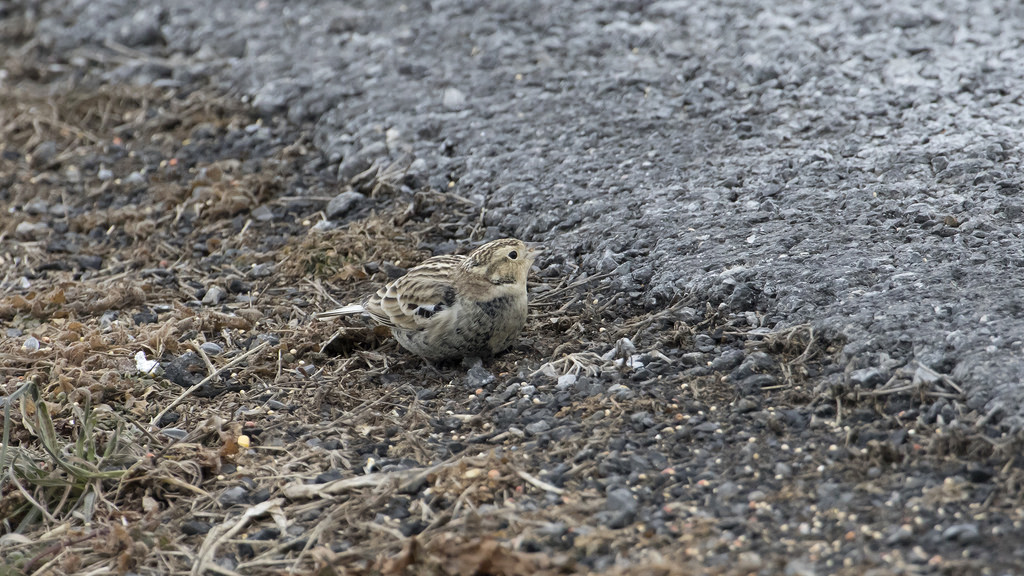Map Snapshot



7 Records
Status
Maryland has two accepted records of Chestnut-collared Longspur. The first was an adult male found near West Ocean City in Worcester County in August 1906 (#1997-363). The second was a well-documented individual found by Tom Feild, Geraldine King, and Jim Green on 1/31/2015 (#2015-006). Documentation for a report from October 1970 at Sandy Point State Park in Anne Arundel Co. was either lost or not sufficient for MD/DCRC acceptance (#1983-030).
Seasonality Snapshot
Source: Wikipedia
| Chestnut-collared longspur | |
|---|---|

| |
| Scientific classification | |
| Domain: | Eukaryota |
| Kingdom: | Animalia |
| Phylum: | Chordata |
| Class: | Aves |
| Order: | Passeriformes |
| Family: | Calcariidae |
| Genus: | Calcarius |
| Species: | C. ornatus
|
| Binomial name | |
| Calcarius ornatus (Townsend, 1837)
| |

| |
The chestnut-collared longspur (Calcarius ornatus) is a species of bird in the family Calcariidae. Like the other longspurs, it is a small ground-feeding bird that primarily eats seeds. It breeds in prairie habitats in Canada and the northern United States and winters to the south in the United States and Mexico.
Description
[edit]These birds have a short conical bill, a streaked back and a white tail with a dark tip. In breeding plumage, the male has black underparts, a chestnut nape, a yellow throat and a black crown. Other birds have light brown underparts, a dark crown, brown wings and may have some chestnut on the nape.
Measurements:
Distribution and status
[edit]This bird breeds in short and mixed grass prairies in central Canada and the north central United States. In winter, they migrate in flocks to prairies and open fields in the southern United States and Mexico. Like other prairie birds, they have disappeared from some areas because of habitat loss but are still fairly common.
Controlled burns may benefit this species as they feed on low-growing plants that are more easily spotted after a fire.[4]
Behavior
[edit]These birds forage on the ground, gathering in flocks in winter. They mainly eat seeds, also eating insects in summer. Young birds are mainly fed insects.
The female lays 4 or 5 eggs in a grass cup nest in a shallow scrape on the ground. The male sings and flies up to defend his territory. Both parents feed the young birds.[5]
The call is a two-syllabled chee dee.
References
[edit]- ^ BirdLife International (2020). "Calcarius ornatus". IUCN Red List of Threatened Species. 2020: e.T22721040A180649581. doi:10.2305/IUCN.UK.2020-3.RLTS.T22721040A180649581.en. Retrieved 18 November 2021.
- ^ a b "Chestnut-collared Longspur Identification, All About Birds, Cornell Lab of Ornithology". www.allaboutbirds.org. Retrieved 2020-09-29.
- ^ Manion, Lani. "Calcarius ornatus (chestnut-collared longspur)". Animal Diversity Web. Retrieved 2020-09-29.
- ^ Prairies to Pines: News from Minnesota, North Dakota, and South Dakota. (Fall 2010 Update). The Nature Conservancy.
- ^ Hill, D. P., and L. K. Gould. 1997. Chesnut-collared Longspur (Calcarius ornatus). In The Birds of North America, No. 288 (A. Poole and F. Gill, eds.). The Academy of Natural Sciences, Philadelphia, PA, and The American Ornithologists' Union, Washington, D.C.
External links
[edit]- Chestnut-collared longspur species account - Cornell Lab of Ornithology
- Chestnut-collared longspur - USGS Patuxent Bird Identification InfoCenter
- Chestnut-collared longspur videos on the Internet Bird Collection
- Chestnut-collared longspur photo gallery VIREO







